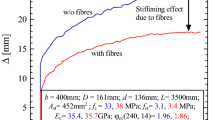Abstract
Knowledge of the mean steel strain, as different from the steel strain at a crack, is of considerable significance in the calculation of crack widths and deflections which are among the important limit-states to be considered in the modern limit-state design concept. Six different theories presently available in literature for predicting the average steel strain in reinforced concrete flexural members have been compared amongst themselves and with test results. It is found that the method proposed by Rao predicts the mean steel strains more accurately than the other methods. On the basis of the earlier theories, the author proposes an empirical equation which fairly agrees with experimental results. The effect of load repetitions on the mean steel strain has been discussed.
Résumé
La rigidité que détermine entre les fissures le béton en traction affecte notablement le comportement des structures pour ce qui regarde les largeurs des fissures et les fléchissements. Étant donné les nombreuses variables qui interviennent dans la fissuration, il n'était pas possible de procéder à un traitement théorique correct du problème. Toutes les théories disponibles à ce jour sont par conséquent nécessairement empiriques ou semi-empiriques par nature. On fait ici brièvement un exposé et une analyse critiques de chaque équation afin d'en juger la validité.
On compare les résultats théoriques à deux séries de résultats expérimentaux. On a constaté en général que les équations de Rao et du Règlement russe donnent une bonne prévision de l'effet raidisseur dû à la traction tandis que les équations de Borgès et du projet de Règlement britannique déterminent une surévaluation. L'équation proposée dans le dernier Règlement britannique sousestime notablement l'effet de raidissement et ne s'écarte pas de beaucoup de l'hypothèse bilinéaire. La congruence des équations de Rao et du Règlement russe doit être surtout attribuée au fait que les deux formulations tiennent compte des trois paramètres majeurs qui interviennent: pourcentage d'armature, résistance en traction du béton, et degré de fissuration, dans la déformation moyenne de l'acier.
Étant donné les inconvénients importants que présentent les équations de Borgès et du Règlement britannique, l'auteur suggère une modification appropriée, en l'espèce la prise en compte du degré de fissuration en tant que paramètre majeur. On constate que l'équation fournit une bonne prévision de la déformation. On considère l'effet de répétition de charges sur la déformation moyenne de l'acier, qui repose sur une étude expérimentale.
Similar content being viewed by others
Abbreviations
- A st :
-
area of tensile reinforcement
- b r :
-
breadth of a rectangular section or web thickness in aT-beam
- d :
-
overall depth of member
- d c :
-
depth to point at which crack width is calculated
- d n :
-
neutral axis depth
- d 1 :
-
effective depth of tensile reinforcement
- E s :
-
modulus of elasticity of steel
- e s :
-
calculated steel strain at a crack at any momentM
- e s m :
-
apparent longitudinal strain (or) mean steel strain at any momentM
- e sm, cr, r :
-
mean steel strain at cracking moment of the reversed section
- f c :
-
characteristic cube strength
- f s, cr :
-
stress in flexural steel at cracking momentM cr
- f s :
-
stress in flexural steel at a crack at any momentM
- f s, y :
-
characteristic (yield) strength of flexural steel
- f t :
-
modulus of rupture of concrete
- K 1 toK 6 :
-
constants
- M :
-
bending moment at section considered
- M cr :
-
cracking moment at section considered
- M cr, r :
-
cracking moment of the reversed section
- P :
-
percentage of tension reinforcement referred to web section
References
Murashev V., Sigalov E., Biakov V.—Design of reinforced concrete structures. MIR Publishers, Moscow, 1968, pp. 82–84 and p. 173.
Borges J. F.—Cracking and deformability of reinforced concrete beams. Vol. 26, Publications, International Association for Bridge and Structural Engineering, Zurich, 1966, pp. 75–95.
Srinivasa Rao P.—Die Grundlagen zur Berechnung der bei statisch unbestimmten Stahlbetonkonstruktionen im Plastischen Bereich auftretenden Umlagerungen der Schnittrafte. Heft 177, Deutscher Ausschuss fur Stahlbeton, Berlin, 1966, 99 p.
Srinivasa Rao P., Subrahmanyam B. V.—Trisegmental moment curvature relations for reinforced concrete members. Proceedings, American Concrete Institute, Vol. 70, No. 5, May 1973, pp. 346–351.
USSR Design Specification No. SNi P II-C, 1-62,Plain reinforced and prestressed concrete structures. German Translation as given in Beton-Kalender, Part II, 1973, pp. 531–656.
Draft British Standard Code of Practice for Structural use of concrete, British Standards Institution, circulated for comment, September 1969, 241 p.
Code of Practice for the Structural use of Concrete-CP 110,Part I, Design, Materials and Workmanship. British Standards Institution, 1972, 154 p.
Bach C., Graf O.—Versuche mit Eisenbetonbalken zur Ermittlung der Beziehung zwischen Formanderungswinkel und Biegungsmoment. Heft 38, Des Deutschen Ausschussen fur Eisenbeton, Berlin, 1917.
Manimurugan R.—Comparative studies of crack widths in concrete beams reinforced with Indian steels. M. Tech. Thesis, Indian Institute of Technology, Madras, 1969.
Rüsch H., Stockl S.—Kennzahlen für das Verhalten einer rechtechigen Biegedruckzone von Stahlbetonbalken unter kurzzeitiger Belastung. Heft 196, Deutscher Ausschuss fur Stahlbeton, Berlin 1967.
Ganesh Babu K.—Behaviour of partially prestressed concrete flexural members under monotomic, slow cycle repeated and fatigue loadings. Ph. D. Thesis, Indian Institute of Technology, Madras, 1976, 316 p.
Subrahmanyam B. V.—Limit state performance of hyperstatic reinforced concrete beam type structures designed for redistribution. Ph. D. Thesis, Indian Institute of Technology, Madras, 1972, 347 p.
Author information
Authors and Affiliations
Rights and permissions
About this article
Cite this article
Babu, K.G. Mean steel strain in reinforced concrete flexural members. Mat. Constr. 12, 207–214 (1979). https://doi.org/10.1007/BF02494252
Issue Date:
DOI: https://doi.org/10.1007/BF02494252




